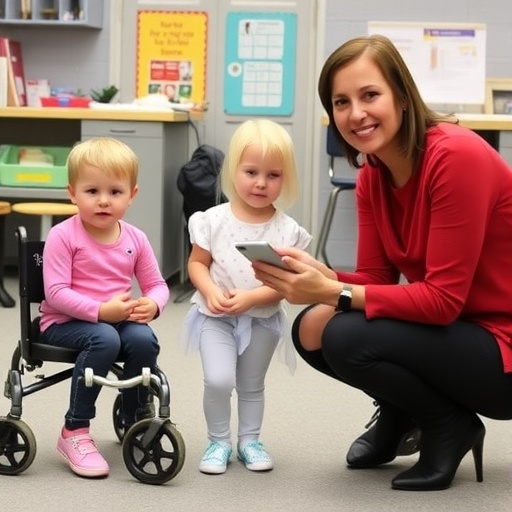In a groundbreaking initiative aimed at enhancing the lives of children with lower extremity amputations, Dr. Quentin Sanders, an Assistant Professor at George Mason University’s College of Engineering and Computing, is embarking on an innovative research project funded by the National Science Foundation. The heart of this project lies in the exploration of Fused Filament Fabrication (FFF), a cutting-edge 3D printing technology that promises to revolutionize the design and production of prosthetic limbs. This endeavor seeks to create customized, continuous fiber prostheses that are not only affordable but also tailored to meet the specific physical activity needs of active children.
Recent advancements in 3D printing technologies have opened new avenues for the manufacturing of prosthetic devices. Unlike traditional methods that often produce prostheses from rigid materials, Fused Filament Fabrication allows for a more flexible and dynamic design, enabling the integration of continuous fibers that provide enhanced strength and durability. This is particularly crucial for children who require prosthetic limbs that can withstand the rigors of play and sports while remaining comfortable and functional.
The long-term vision for this research project extends beyond the simple creation of prosthetic limbs. Dr. Sanders and his collaborators aim to address the multifaceted challenges that children with amputations face, particularly in their desire to engage in physical activities. The first objective of this research focuses on understanding the qualitative and quantitative factors that influence a child’s motivation to participate in physical play. This involves a nuanced analysis of the emotional and psychological aspects of their experiences, ensuring that the developed prostheses align with their aspirations and lifestyle.
To achieve this, Dr. Sanders and his team are employing advanced methodologies to gauge how children perceive physical activity alongside their needs for mobility and engagement. This inquiry is not only instrumental in shaping the design of prosthetic devices but also crucial in fostering an environment where children feel empowered to participate in various physical activities without limitations.
In parallel with this objective, the research seeks to quantify the impact of child anthropometry—that is, the measurement of physical dimensions—on the mechanical properties of prostheses designed for running and other vigorous activities. Understanding the biomechanical requirements necessitates thorough research into the specific movements and force interactions that children experience during physical activities. By meticulously examining these parameters, the team hopes to establish benchmarks that can guide the design of prostheses to mimic the natural biomechanics of running.
Moreover, as part of their commitment to empirical validation, Dr. Sanders’ research project will make critical comparisons between the performance of continuous fiber 3D printed prostheses and those manufactured using conventional laminate techniques. This comparative analysis will evaluate both static and dynamic behaviors under various load conditions, thereby generating insightful data about the resilience and functionality of the prosthetic limbs. Such evaluations are poised to provide compelling evidence that could steer innovation in materials and design principles used in prosthetic technology across the healthcare sector.
The support from the National Science Foundation, amounting to an impressive $502,222, underscores the importance and potential impact of this research. The funding, which commenced in September 2025 and is set to conclude in August 2028, will allow Dr. Sanders and his team to pursue these ambitious objectives with the resources necessary to make groundbreaking advancements in pediatric prosthetics. This financial backing is a testament to the growing recognition of the role that innovative engineering solutions can play in addressing complex healthcare challenges.
As this research unfolds, it is expected to generate significant interest not only within the academic and medical communities but also among families and organizations supporting children with disabilities. The implications of such advancements stretch far beyond the technical specifications of prosthetic limbs; they resonate deeply with the social and emotional aspects of a child’s development and quality of life. By creating prostheses that truly embrace and elevate physical activity, Dr. Sanders’ work promises to empower children with amputations, enabling them to engage fully in sports and play.
Furthermore, the research holds the potential for broader ramifications within the field of bioengineering. The methodologies and outcomes derived from this study could serve as a model for future innovation in prosthetic design, influencing techniques used for both adults and pediatric populations. Additionally, as researchers strive to translate these findings into commercial products, there may be a significant reduction in costs, thereby improving access for families who face financial constraints in sourcing quality prosthetic devices for their children.
Dr. Sanders’ research journey epitomizes the intersection of engineering, healthcare, and community activism—a synthesis that highlights the urgent need for tailored healthcare solutions in an increasingly diverse society. As the project progresses, the anticipated collaboration with various stakeholders, including healthcare professionals, disability advocates, and the families of children with amputations, is likely to enrich the research process and enhance its real-world applicability.
In summary, Dr. Quentin Sanders’ commitment to pioneering advanced prosthetic solutions is creating a ripple effect of hope and inspiration. The methodological rigor and compassionate approach characterize this innovative venture, which seeks to redefine what is possible for children with lower extremity amputations. By focusing on the integration of cutting-edge technology with the needs and desires of its young users, this research promises to open new pathways towards inclusivity and empowerment.
Subject of Research: Fused Filament Fabrication of Customized Continuous Fiber Prostheses for Children with Lower Extremity Amputation
Article Title: Revolutionizing Prosthetics: Advanced 3D Printing Techniques for Children’s Mobility
News Publication Date: October 2023
Web References: George Mason University
References: National Science Foundation
Image Credits: George Mason University




